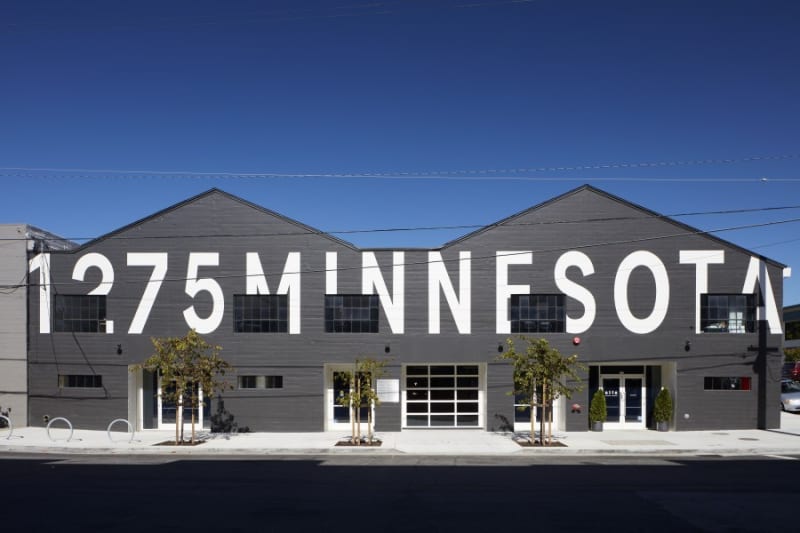With the aim of providing upcoming San Francisco artists with an affordable place to create and display their work, two art collectors conceived the Minnesota Street Project in the Dogpatch neighborhood.
As the birthplace of 1960s counterculture. fortune cookies, denim jeans, and California cuisine, San Francisco has always been regarded as an innovative and creative city where residents embrace new experiences, political and social activism, and artistic energy.
In early 2016, concerned when artists were being priced out of the city and seeking to maintain San Francisco’s place in the contemporary art world, art collectors Deborah and Andy Rappaport founded the Minnesota Street Project. Occupying three warehouses
in the Dogpatch neighborhood, the Minnesota Street Project includes 35,000 sq ft of gallery space. along with subsidized studio space and an advanced art collection management facility that allows collectors to regularly rotate and share their work. All of the profits are used to support the artists, galleries, and institutions within the Minnesota Street Project.
Inspired by their shared belief that philanthropic support for the arts now requires innovation and creativity - with Minnesota Street Project, the Rappaports hope to retain and strengthen San Francisco’s contemporary art community in the short term, while developing an internationally recognized arts destination in the long term. Julie Casemore, Director of Minnesota Street Project, explained
that between the studio workspaces, aIl permanent gallery tenants that include mainstays such as Rena Bransten Gallery and newcomers like Bass & Reiner, three spaces for rotating exhibitions, and the revolutionary art services and storage facility—“we have created an ecosystem of the art world.”
Minnesota Street Project’s studio program is also a vital component of the Rappaports’ approach to directly supporting artists. Created to be a refuge for emerging artists who have been priced out of gentrifying neighborhoods, the studio program provides artists with affordable private studios in a campus environment with shared space and resources.
Software giant Adobe subsidizes the cost of the artists' studio spaces at 1240 Minnesota Street and has a space of its own there, operated by its technology research teams. Lisa Temple, Adobe’s head of Community Innovation and Collaboration, explained the company's desire to "place
our staff where they can have innovative conversations,” and to "create connections.”
Minnesota Street Project also provides space for the San Francisco Arts Education Project (SFArtsED).Over the past 20years, SFArtED has earned a reputation as the city’s most comprehensive arts education program, thanks to its hands-on creative experiences for local public schoolchildren, in-school artist residencies with some of the BayArea's finest practicing artists, after-school and weekend programs, and
a six-week arts summer camp.
Eleanor Harwood, who exhibits emerging artists in her gallery, said Minnesota Street Project not only provides foot traffic. but has also “created a collaborative art environment where artists have the unique opportunity to engage and share ideas with other artists and gallerists on a daily basis.”
Communal support for the artists includes a shipping and packing space designed especially for gallery tenants and exhibition spaces outside of the individual galleries.
Another important addition to this space and the neighborhood is Alta MSP, an inviting, cozy 45-seat neighborhood restaurant by influential Chef Daniel Patterson. Designed by the chef himself, Alta MSP features communal tables and an open kitchen, and showcases murals by artist Catherine Wagner.
In summer 2017, more than 10,000 people ventured to Dogpatch for San Francisco's second Art Book Fair, a now- annual collaboration between Minnesota Street Project, Colpa Press, and Park Life store and gallery. The three-day fair celebrated great art publishing and provided a place for independent artists to get together and show off their work to a wider audience.
On the first Saturday of each month, galleries at Minnesota Street Project present unique opportunities for collectors and neophytes to explore and engage with the contemporary art galleries in a relaxed and welcoming atmosphere. A stark 4,600 sq ft atrium with exposed steel beams and polished concrete floors hosts a variety of events throughout the year, exposing even more visitors to the artists and galleries.
Dogpatch: where art blooms
One of the few neighborhoods to survive the1906 San Francisco earthquake and fire, Dogpatch is a gateway to the oldest, largest, and most intact historic industrial complex remaining in the city. At first glance, this gritty enclave appears to be made up of warehouses and rundown public buildings—but the hum of construction and steady weekday traffic tell you something is hiding beneath the surface of this traditionally working-class neighborhood.
Long-abandoned factories are rapidly becoming condominiums and apartments—a surge in new housing has doubled the number of units and residents in 2017. The recently remodeled Dogpatch Saloon—one of the neighborhood's oldest pubs—has been joined by eclectic and under-the-radar spots offering everything from southern homestyle chicken to sourdough thin-crust pizza and locally brewed beer.
Four years ago, the Museum of Craft and Design moved from Union Square to the American Industrial Center, a former cannery. UNTITLED, a renowned international contemporary art fair found a home here at Pier 70, a 65-acre former ironworks and shipbuilding site.
Hard to believe that Dogpatch was once a colloquialism for "an underdeveloped backwater."

